Evaluation Method of Soil Surface Roughness after Ditching Operation Based on Wavelet Transform
Abstract
:1. Introduction
2. Materials and Methods
2.1. Design of Ditching Test and Measurement of Surface Roughness
2.1.1. Indoor Soil Bin Test Design
2.1.2. Preparation and Measurement of SSR Measuring Device
2.2. Evaluation of SSR
2.2.1. Data Preprocessing
2.2.2. Extraction of Random Surface Roughness Features Based on Wavelet Transform
2.2.3. Evaluation Parameters of 3D Morphology
2.3. Data Analysis
3. Results and Discussion
3.1. Digital Model of Soil Surface under Different Ditching Depths
3.2. Digital Model of Soil Surface after Wavelet Transform
3.3. Analysis of Surface Roughness Calculation Results
3.3.1. Analysis of RMSH Calculation Results
3.3.2. Analysis of CL Calculation Results
3.3.3. Comparative Analysis of Roughness Parameters in Different Directions
3.4. Impact of Ridges and Furrows on Evaluation of Surface Roughness in Local Area
4. Conclusions
Author Contributions
Funding
Institutional Review Board Statement
Informed Consent Statement
Data Availability Statement
Conflicts of Interest
References
- Darboux, F.; Davy, P.; Gascuel-Odoux, C.; Huang, C. Evolution of soil surface roughness and flowpath connectivity in overland flow experiments. Catena 2002, 46, 125–139. [Google Scholar] [CrossRef]
- Peñuela, A.; Javaux, M.; Bielders, C.L. How do slope and surface roughness affect plot-scale overland flow connectivity? J. Hydrol. 2015, 528, 192–205. [Google Scholar] [CrossRef]
- Zhiqang, L.; Liqing, C.; Quan, Z.; Xianyao, D.; Lu, Y. Control of a path following caterpillar robot based on a sliding mode variable structure algorithm. Biosyst. Eng. 2019, 186, 293–306. [Google Scholar]
- Liqing, C.; Pinpin, W.; Peng, Z.; Quan, Z.; Jin, H.; Qingjie, W. Performance analysis and test of a maize inter-row self-propelled thermal fogger chassis. Int. J. Agric. Biol. Eng. 2018, 11, 100–107. [Google Scholar]
- Xingming, Z.; Tao, J.; Xiaofeng, L.; Yanling, D.; Kai, Z. The temporal variation of farmland soil surface roughness with various initial surface states under natural rainfall conditions. Soil Tillage Res. 2017, 170, 147–156. [Google Scholar] [CrossRef]
- Gessesse, G.D.; Fuchs, H.; Mansberger, R.; Klik, A.; Rieke-Zapp, D.H. Assessment of erosion, deposition and rill development on irregular soil surfaces using close range digital photogrammetry. Photogramm. Rec. 2010, 25, 299–318. [Google Scholar] [CrossRef]
- Beaudoin, A.; Le Toan, T.; Gwyn, Q. SAR observations and modeling of the C-band backscatter variability due to multiscale geometry and soil moisture. IEEE Trans. Geosci. Remote Sens. 1990, 28, 886–895. [Google Scholar] [CrossRef]
- Moreno, R.G.; Alvarez, M.D.; Requejo, A.S.; Delfa, J.V.; Tarquis, A. Multiscaling analysis of soil roughness variability. Geoderma 2010, 160, 22–30. [Google Scholar] [CrossRef]
- Thomsen, L.; Baartman, J.; Barneveld, R.; Starkloff, T.; Stolte, J. Soil surface roughness: Comparing old and new measuring methods and application in a soil erosion model. Soil 2015, 1, 399–410. [Google Scholar] [CrossRef] [Green Version]
- Polyakov, V.; Nearing, M. A simple automated laser profile meter. Soil Sci. Soc. Am. J. 2019, 83, 327–331. [Google Scholar] [CrossRef] [Green Version]
- Xingming, Z.; Lei, L.; Chunmei, W.; Leran, H.; Tao, J.; Xiaojie, L.; Zhuangzhuang, F. Measuring surface roughness of agricultural soils: Measurement error evaluation and random components separation. Geoderma 2021, 404, 115393. [Google Scholar] [CrossRef]
- Xu, L.; Zheng, C.; Wang, Z.; Nyongesah, M. A digital camera as an alternative tool for estimating soil salinity and soil surface roughness. Geoderma 2019, 341, 68–75. [Google Scholar] [CrossRef]
- Grundy, L.; Ghimire, C.; Snow, V. Characterisation of soil micro-topography using a depth camera. MethodsX 2020, 7, 101144. [Google Scholar] [CrossRef] [PubMed]
- Lou, S.; He, J.; Lu, C.; Liu, P.; Li, H.; Zhang, Z. A Tillage Depth Monitoring and Control System for the Independent Adjustment of Each Subsoiling Shovel. Actuators 2021, 10, 250. [Google Scholar] [CrossRef]
- Mohammadi, F.; Maleki, M.R.; Khodaei, J. Control of variable rate system of a rotary tiller based on real-time measurement of soil surface roughness. Soil Tillage Res. 2022, 215, 105216. [Google Scholar] [CrossRef]
- Ehlert, D.; Adamek, R.; Horn, H.J. Laser rangefinder-based measuring of crop biomass under field conditions. Precis. Agric. 2009, 10, 395–408. [Google Scholar] [CrossRef]
- Jensen, T.; Karstoft, H.; Green, O.; Munkholm, J.L. Assessing the effect of the seedbed cultivator leveling tines on soil surface properties using laser range scanners. Soil Tillage Res. 2017, 167, 54–60. [Google Scholar] [CrossRef]
- Foldager, F.F.; Pedersen, J.M.; Haubro Skov, E.; Evgrafova, A.; Green, O. Lidar-based 3d scans of soil surfaces and furrows in two soil types. Sensors 2019, 19, 661. [Google Scholar] [CrossRef] [Green Version]
- Riegler, T.; Rechberger, C.; Handler, F.; Prankl, H. Image processing system for evaluation of tillage quality. Landtechnik 2014, 69, 125–131. [Google Scholar]
- Jiang, C.; Fang, H.; Wei, S. Review of Land Surface Roughness Parameterization Study. Adv. Earth Sci. 2012, 27, 292–303. [Google Scholar]
- Fanigliulo, R.; Antonucci, F.; Figorilli, S.; Pochi, D.; Pallottino, F.; Fornaciari, L.; Costa, C. Light drone-based application to assess soil tillage quality parameters. Sensors 2020, 20, 728. [Google Scholar] [CrossRef] [PubMed] [Green Version]
- Onnen, N.; Eltner, A.; Heckrath, G.; Van Oost, K. Monitoring soil surface roughness under growing winter wheat with low-altitude UAV sensing: Potential and limitations. Earth Surf. Process. Landf. 2020, 45, 3747–3759. [Google Scholar] [CrossRef]
- Martinez-Agirre, A.; Alvarez-Mozos, J.; Gimenez, R. Evaluation of surface roughness parameters in agricultural soils with different tillage conditions using a laser profile meter. Soil Tillage Res. 2016, 161, 19–30. [Google Scholar] [CrossRef] [Green Version]
- Turner, R.; Panciera, R.; Tanase, M.A.; Lowell, K.; Hacker, J.M. Estimation of soil surface roughness of agricultural soils using airborne LiDAR. Remote Sens. Environ. 2014, 140, 107–117. [Google Scholar] [CrossRef]
- Vannier, E.; Ciarletti, V.; Darboux, F. Wavelet-based detection of clods on a soil surface. Comput. Geosci. 2009, 35, 2259–2267. [Google Scholar] [CrossRef]
- Barton, D.; Federhen, J.; Fleischer, J. Retrofittable vibration-based monitoring of milling processes using wavelet packet transform. Procedia CIRP 2021, 96, 353–358. [Google Scholar] [CrossRef]
- Hou, W.; Zhang, D.; Wei, Y.; Guo, J.; Zhang, X. Review on computer aided weld defect detection from radiography images. Appl. Sci. 2020, 10, 1878. [Google Scholar] [CrossRef] [Green Version]
- Wang, H.; Chi, G.; Jia, Y.; Ge, C.; Yu, F.; Wang, Z.; Wang, Y. Surface roughness evaluation and morphology reconstruction of electrical discharge machining by frequency spectral analysis. Measurement 2021, 172, 108879. [Google Scholar] [CrossRef]
- Vannier, E.; Dusséaux, R.; Taconet, O.; Darboux, F. Wavelet-based clod segmentation on digital elevation models of a soil surface with or without furrows. Geoderma 2019, 356, 113933. [Google Scholar] [CrossRef]
- Liu, Y.; Zheng, Y.; Li, J.; Jing, D.; Gu, Y. Study on Surface Morphology of Vibration Assisted Cutting. Procedia CIRP 2018, 71, 65–70. [Google Scholar] [CrossRef]
- Youming, Z. Wavelet Packet Time-Frequency Analysis and Its Property. J. Vib. Meas. Diagn. 2009, 29, 170. [Google Scholar]
- Xingming, Z.; Kai, Z.; Xiaojie, L.; Yangyang, L.; Jianhua, R. Improvements in farmland surface roughness measurement by employing a new laser scanner. Soil Tillage Res. 2014, 143, 137–144. [Google Scholar] [CrossRef]
- Yang, P.; Jiang, S. The study on the 3D assessment of surface roughness. Mach. Des. Res. 2002, 18, 64–67. [Google Scholar]
- Sanner, A.; Nöhring, W.G.; Thimons, L.A.; Jacobs, T.D.B.; Pastewka, L. Scale-dependent roughness parameters for topography analysis. Appl. Surf. Sci. Adv. 2022, 7, 100190. [Google Scholar] [CrossRef]
- Zhixiong, L.; Nan, C.; Perdok, U.; Hoogmoed, W. Characterisation of Soil Profile Roughness. Biosyst. Eng. 2005, 91, 369–377. [Google Scholar] [CrossRef]
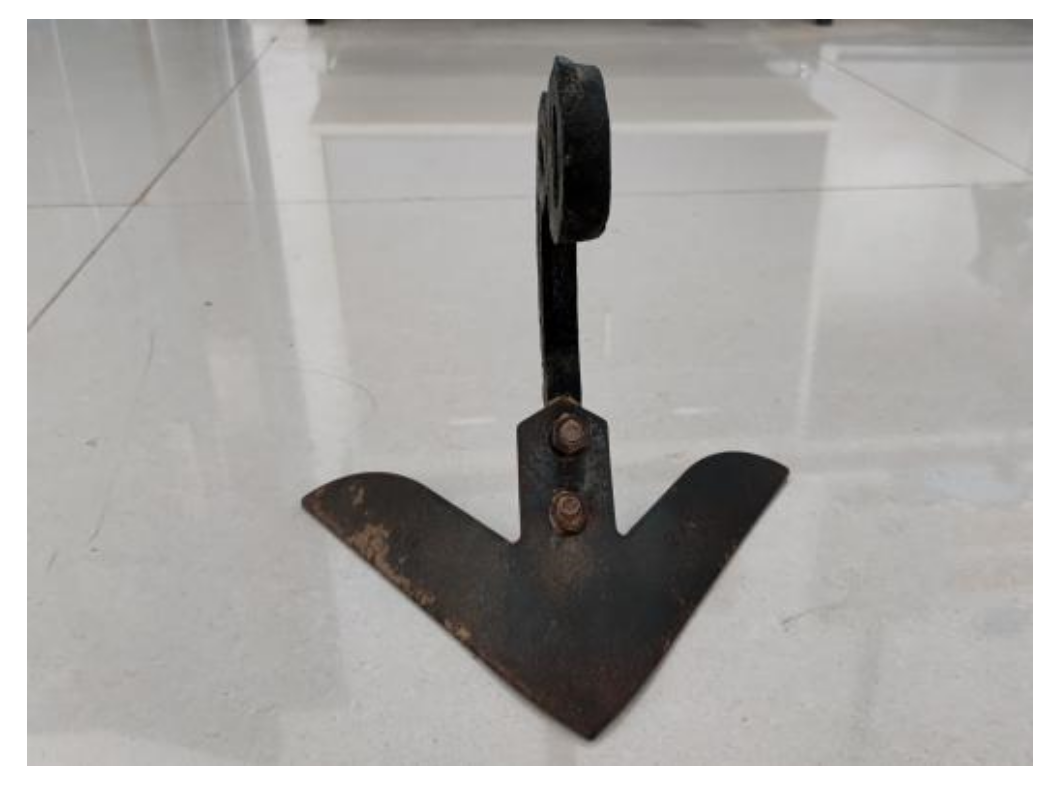
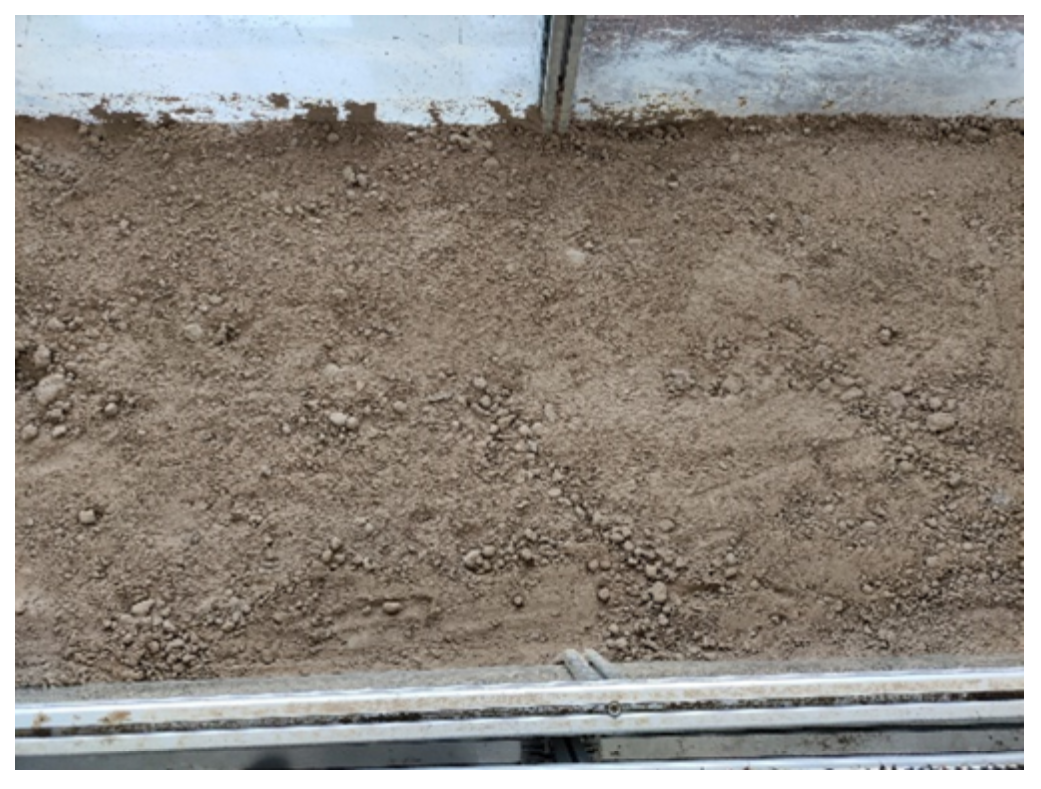
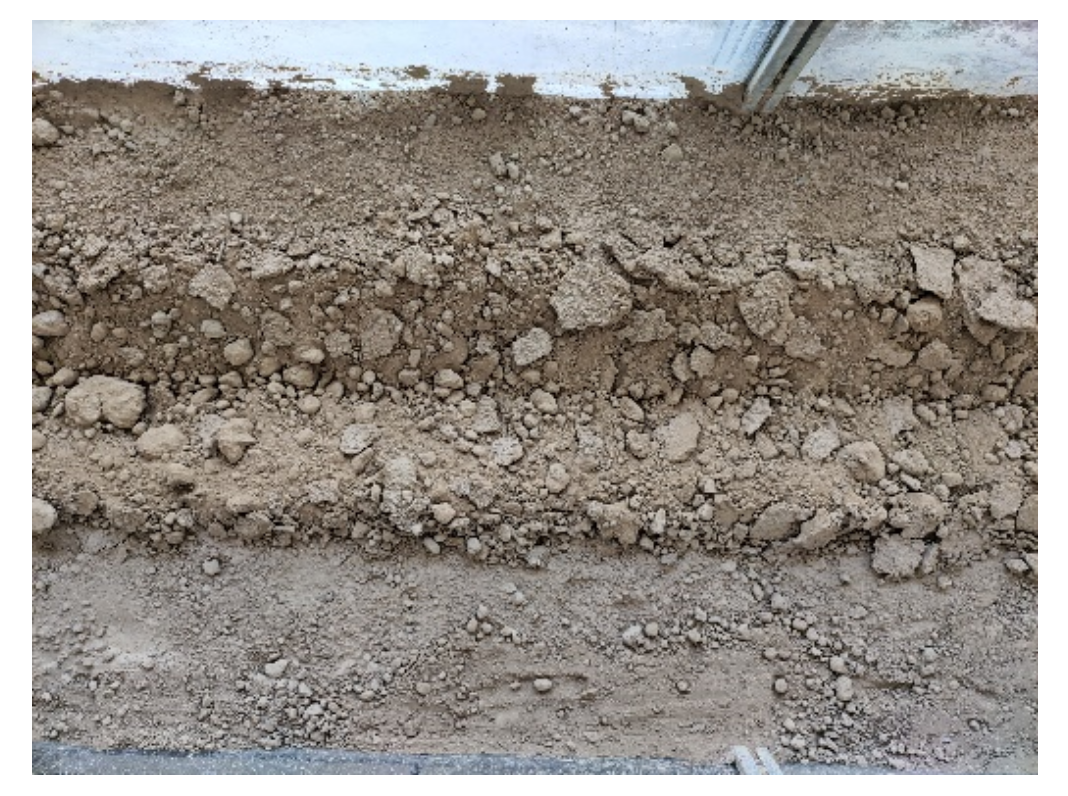
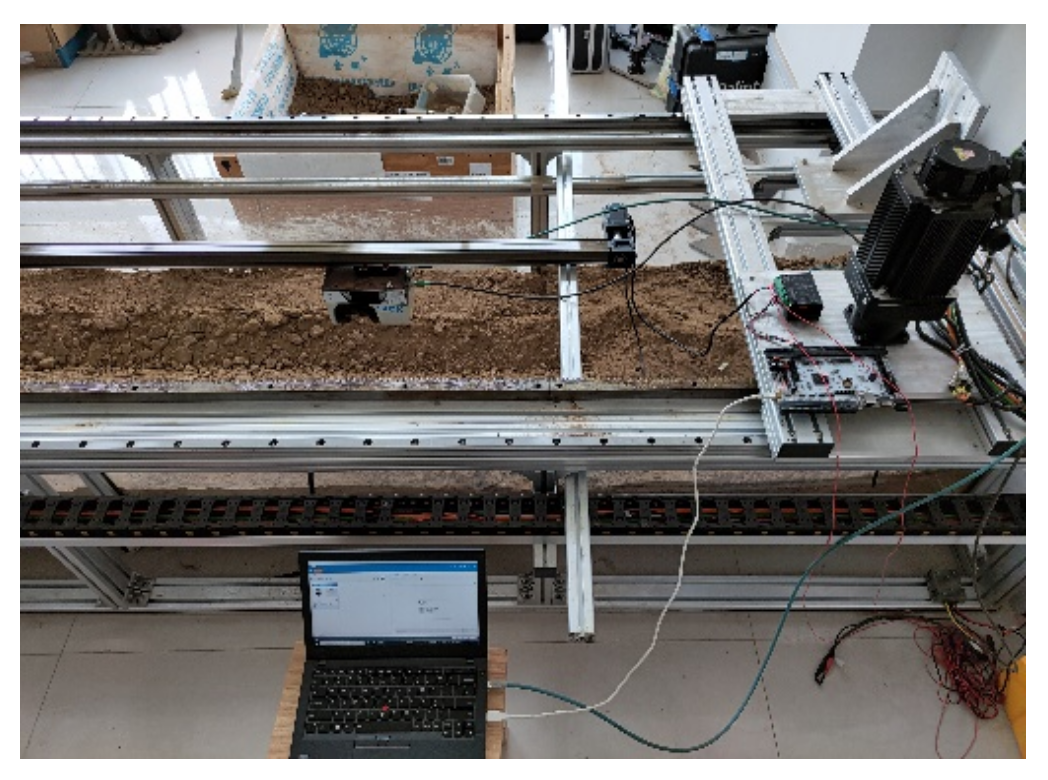
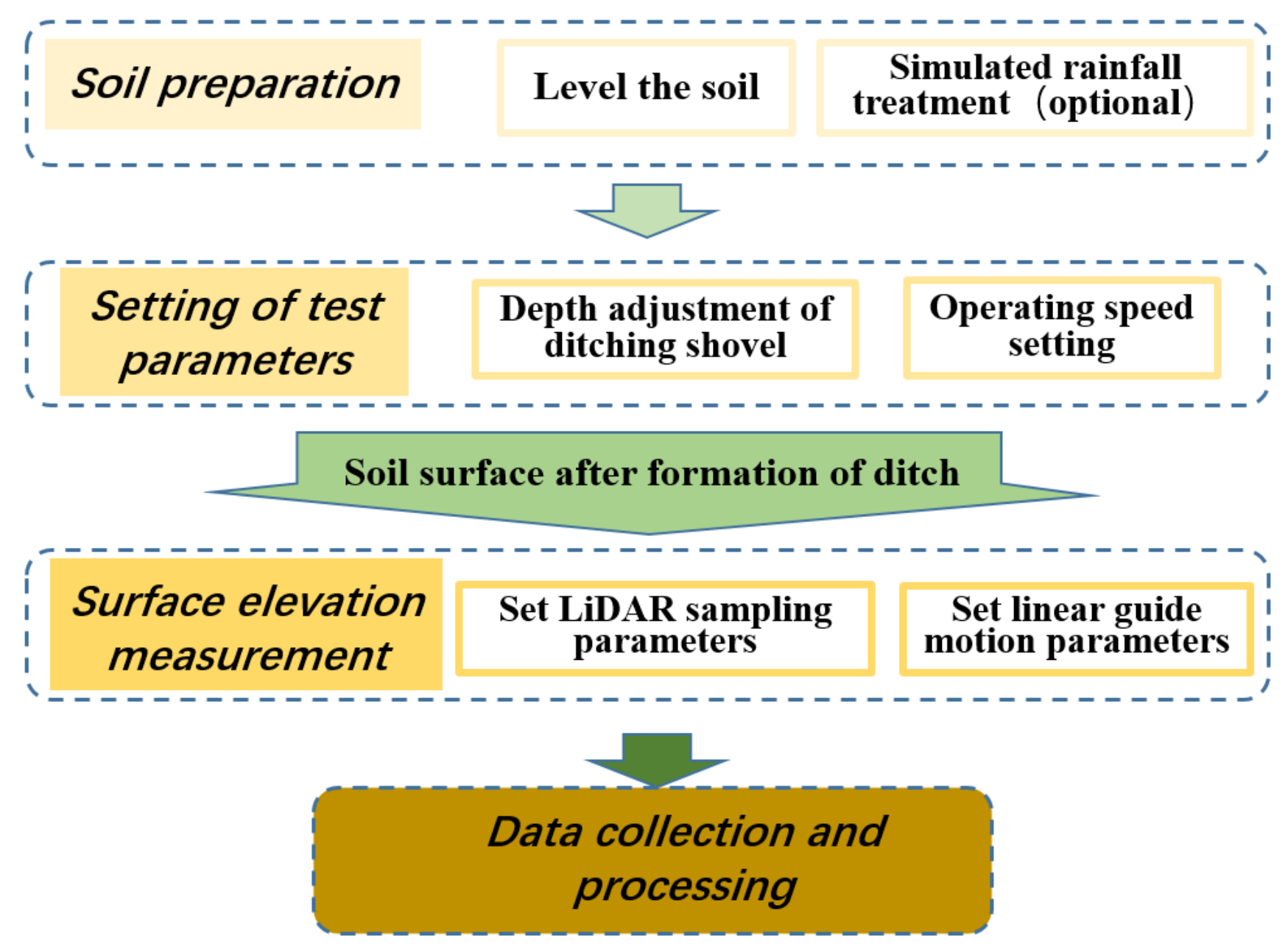
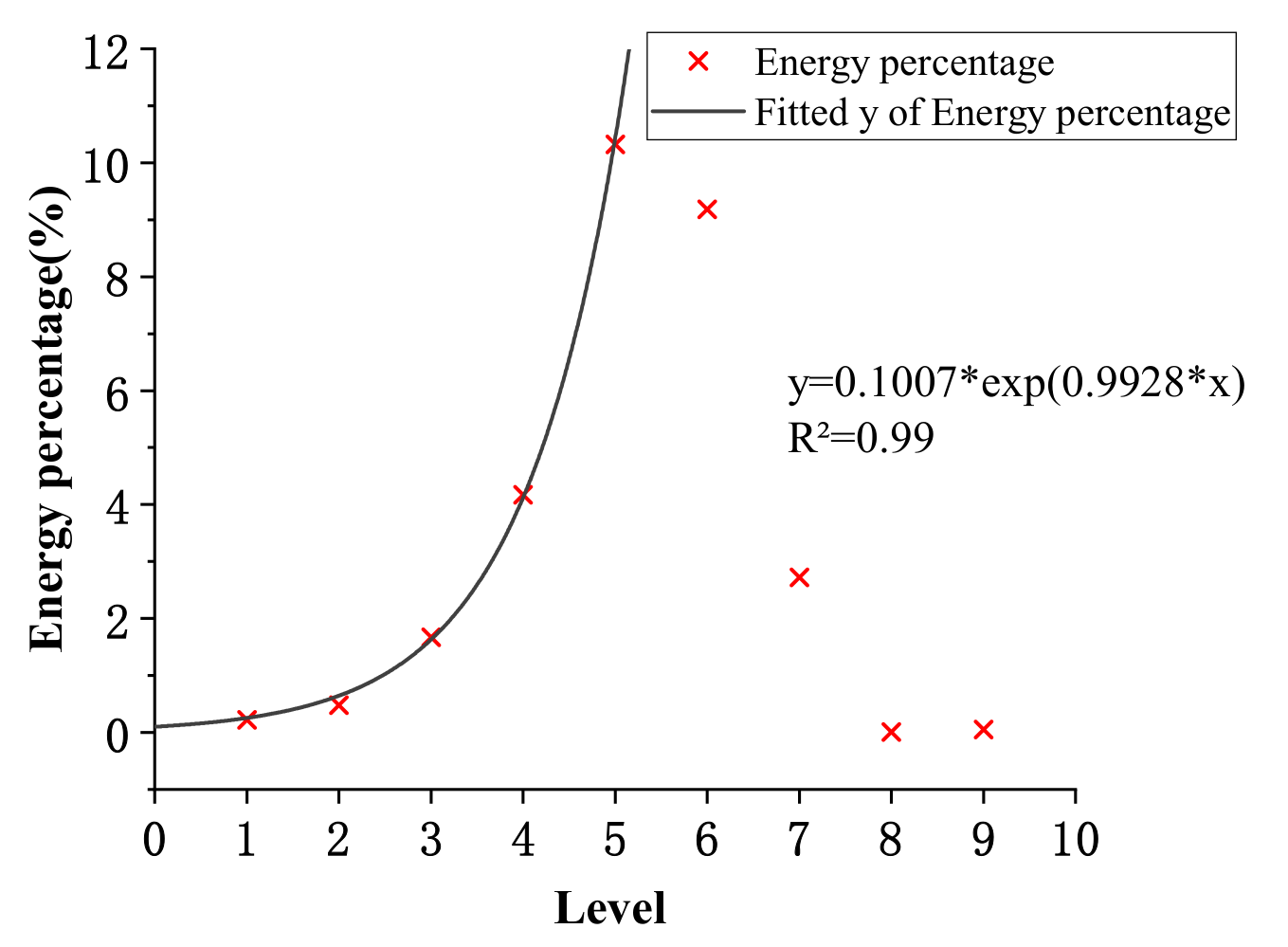
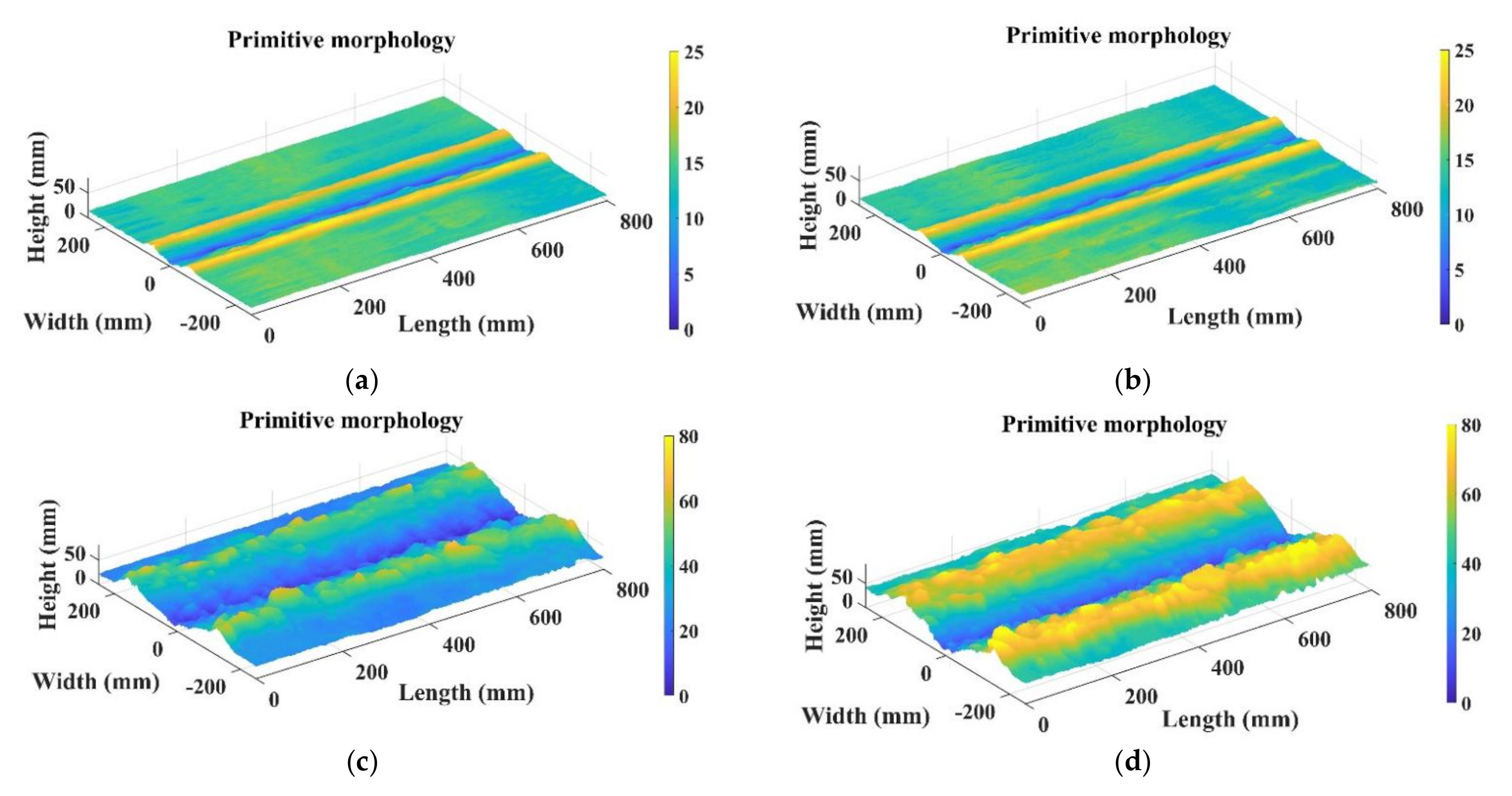

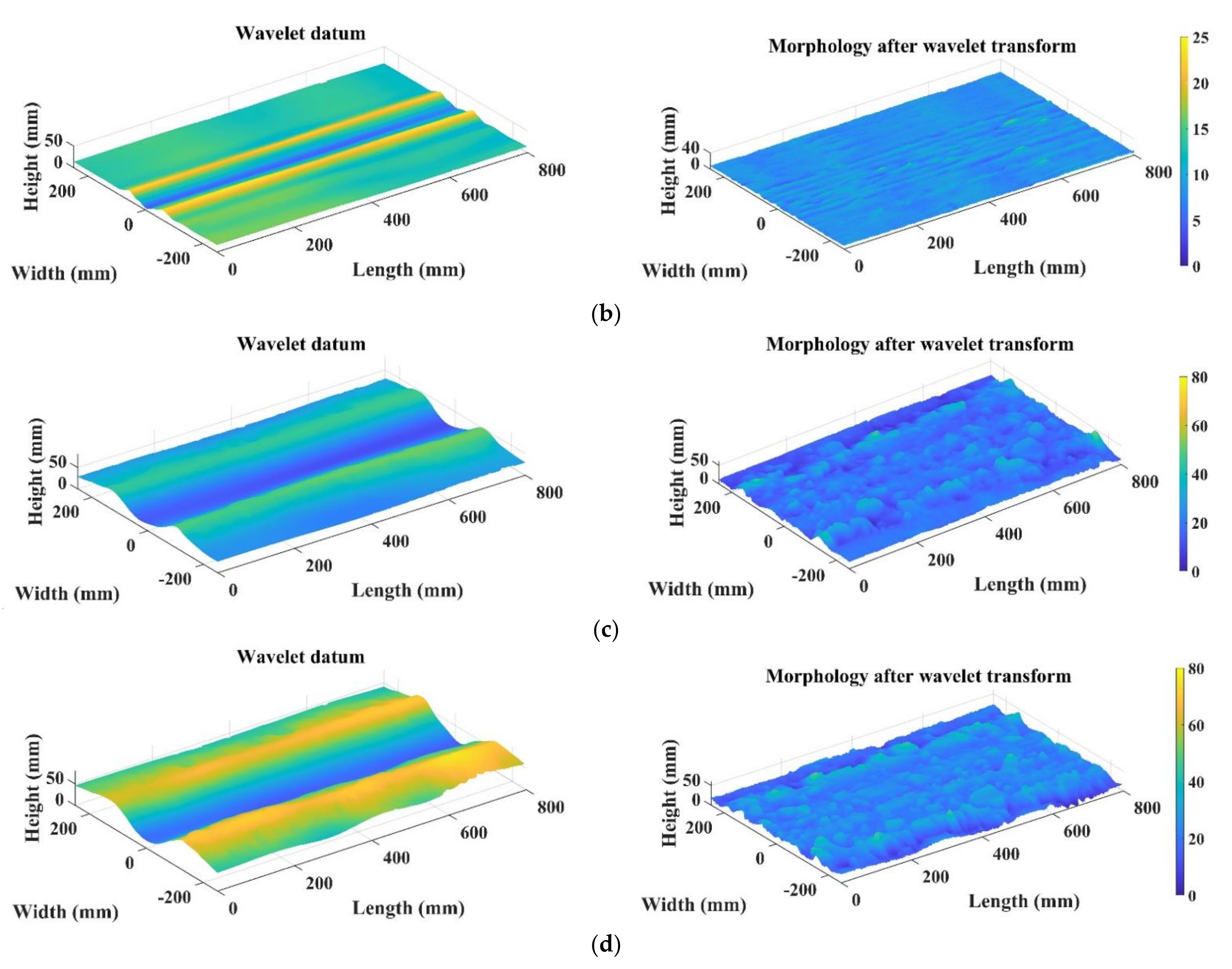


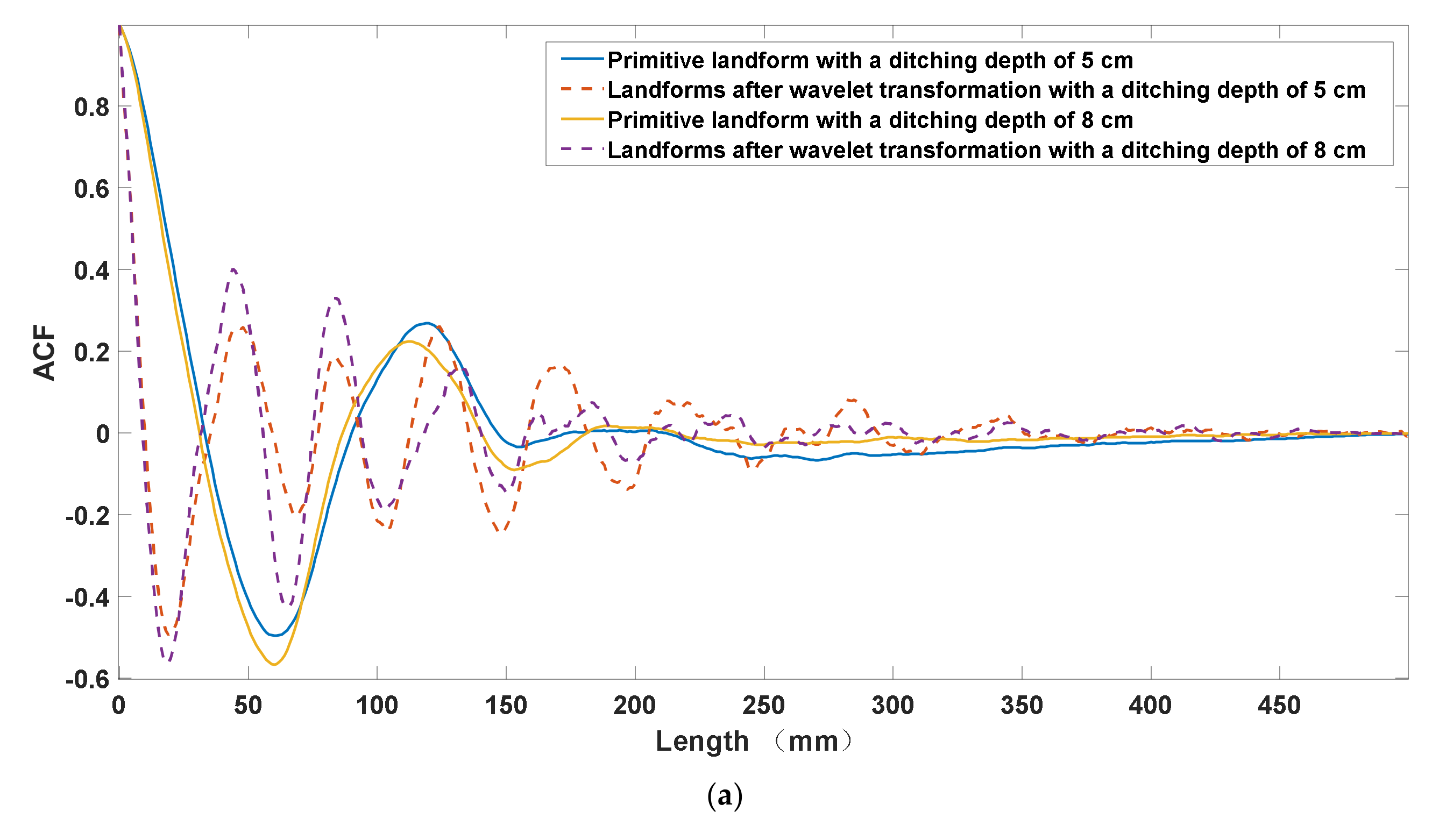
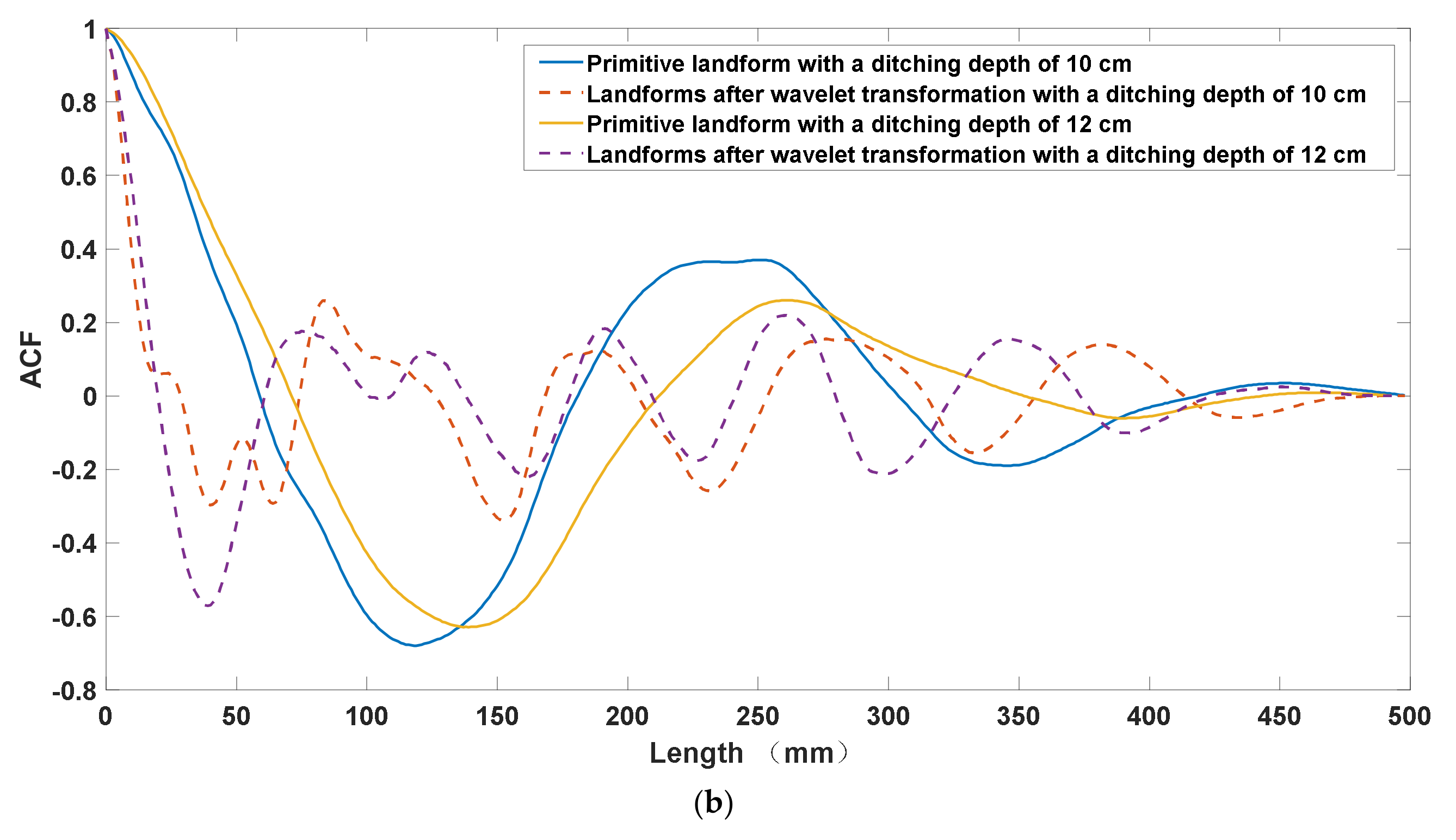

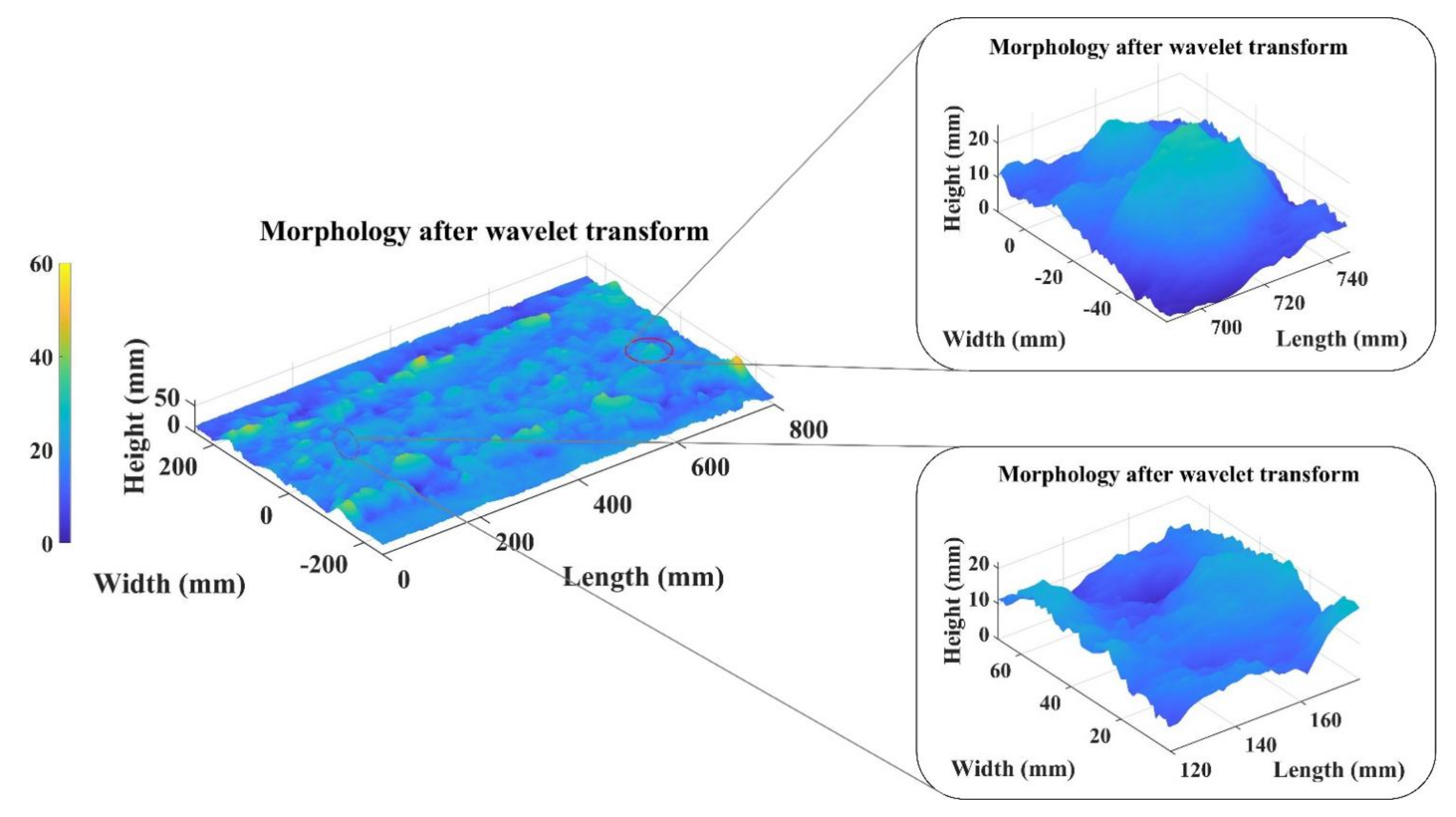
| Ditching Depth/cm | 5 | 8 | 10 | 12 |
|---|---|---|---|---|
| Before wavelet transform/mm | 3.37 | 3.45 | 12.16 | 17.03 |
| After wavelet transform/mm | 1.11 | 1.12 | 4.05 | 4.59 |
| Range of change/% | 203.60 | 208.04 | 200.24 | 271.02 |
| Ditching Depth | Data Type | Cross-Section Serial Number | Average Value | ||||
|---|---|---|---|---|---|---|---|
| 1 | 2 | 3 | 4 | 5 | |||
| 5 cm | Original surface CL | 23.26 | 24.11 | 21.78 | 21.44 | 21.73 | 22.46 |
| Surface CL after wavelet transform | 16.73 | 15.15 | 16.94 | 15.19 | 14.38 | 15.68 | |
| 8 cm | Original surface CL | 23.65 | 23.55 | 23.89 | 23.13 | 22.88 | 23.42 |
| Surface CL after wavelet transform | 15.02 | 15.15 | 14.47 | 16.39 | 17.08 | 15.62 | |
| 10 cm | Original surface CL | 43.11 | 41.73 | 38.78 | 45.09 | 40.76 | 41.89 |
| Surface CL after wavelet transform | 18.94 | 15.73 | 17.78 | 20.76 | 18.80 | 18.40 | |
| 12 cm | Original surface CL | 49.91 | 47.40 | 50.08 | 51.18 | 53.01 | 50.32 |
| Surface CL after wavelet transform | 23.26 | 24.11 | 21.78 | 21.44 | 21.73 | 22.46 | |
| Ditching Depth (cm) | Before Wavelet Transform | After Wavelet Transform | ||||||||||
|---|---|---|---|---|---|---|---|---|---|---|---|---|
| 0° | 45° | 90° | 0° | 45° | 90° | |||||||
| RMSH | CL | RMSH | CL | RMSH | CL | RMSH | CL | RMSH | CL | RMSH | CL | |
| 5 | 3.34 | 21.32 | 3.18 | 21.24 | 1.30 | 48.74 | 1.06 | 6.29 | 1.03 | 6.77 | 1.08 | 32.33 |
| 8 | 3.37 | 19.86 | 3.82 | 24.48 | 0.96 | 20.14 | 1.18 | 7.05 | 1.01 | 6.01 | 0.78 | 10.42 |
| 10 | 13.34 | 38.50 | 13.26 | 39.27 | 5.91 | 32.91 | 4.76 | 17.52 | 3.64 | 12.86 | 4.62 | 17.68 |
| 12 | 17.36 | 51.48 | 15.96 | 48.56 | 5.16 | 26.69 | 4.57 | 15.96 | 4.54 | 12.97 | 3.78 | 13.40 |
| Area | RMSH (Mm) | RMSH after Wavelet Transform (Mm) | Amplitude of Change (%) |
|---|---|---|---|
| Convex area | 7.57 | 5.12 | 47.78 |
| Concave area | 5.14 | 3.51 | 46.41 |
Publisher’s Note: MDPI stays neutral with regard to jurisdictional claims in published maps and institutional affiliations. |
© 2022 by the authors. Licensee MDPI, Basel, Switzerland. This article is an open access article distributed under the terms and conditions of the Creative Commons Attribution (CC BY) license (https://creativecommons.org/licenses/by/4.0/).
Share and Cite
Liu, L.; Bi, Q.; Zhang, Q.; Tang, J.; Bi, D.; Chen, L. Evaluation Method of Soil Surface Roughness after Ditching Operation Based on Wavelet Transform. Actuators 2022, 11, 87. https://doi.org/10.3390/act11030087
Liu L, Bi Q, Zhang Q, Tang J, Bi D, Chen L. Evaluation Method of Soil Surface Roughness after Ditching Operation Based on Wavelet Transform. Actuators. 2022; 11(3):87. https://doi.org/10.3390/act11030087
Chicago/Turabian StyleLiu, Lichao, Quanpeng Bi, Qianwei Zhang, Junjie Tang, Dawei Bi, and Liqing Chen. 2022. "Evaluation Method of Soil Surface Roughness after Ditching Operation Based on Wavelet Transform" Actuators 11, no. 3: 87. https://doi.org/10.3390/act11030087






